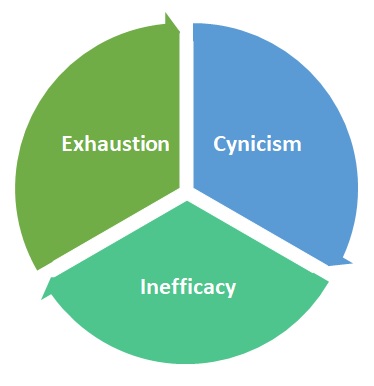Certainly, stress is unavoidable but how someone responds to it can make the difference. School administration is shouldering the tremendous responsibility. Nevertheless, the pressure of this disrupted school year (as a consequence of Covid-19) is impacting all educators as well as the school management. To address this pressure, school management must find approaches to battle burnout and build helpful teaching environments.
Consequences of Burnout
With time, burnout can lead to variability of responses. Additionally, the World Health Organization defines burnout as an occupational phenomenon characterized by three main attributes:

1. Exhaustion. When teachers or school leaders experience burnout, they feel exhausted and too tired to continue with their work.
2. Cynicism. Teachers or school leaders who have reached a state of burnout can start to feel disconnected from their jobs. Their feelings about the profession can turn negative and skeptical.
3. Inefficacy. Teacher’s or school leader’s burnout also leads to feelings of ineffectiveness or ineptitude.
If you ask the causes and reasons behind this burnout then you will see the reasons are enormous. Some of the major causes of teacher burnout include - Poor Funding, High Emotional Demands, Inadequate Preparation, Challenging Teaching Situations, etc.
Ideas on How to Get Started
Try these out -
Survey
With the determination to support teachers, as well as school staff, manage stress, school leaders can survey and listen to them. Check with educators and staff via an online survey focused on wellness - and listen to what they want.
More Teacher Autonomy
More autonomy can advance job satisfaction and retention. The connection between teacher autonomy and retention is very strong. Consider how to give educators more control over the courses they select and the content they teach. This can suggestively affect their self-esteem and motivate them to stay.
Emotional First-aid
If you see yourself taking your classroom work home with you, try to avoid that. Practice emotional first aid. Sometimes, a two-minute commotion is all that is needed to avoid digging yourself into an emotional channel.
Address Signs of Burnout
Burnout does not appear overnight. Implement programs that address the symptoms that lead to it. It is necessary to build the trust among the staff that the administration will take essential steps to address their symptoms. Maybe clear policies and procedures about reporting teacher burnout can be implemented.
Give (Actual) Break
Take a breath, and get back on track. The classroom can cause a sensory burden. Believe it or not, in these situations, the most effective first step you can take is to breathe deeply. Breathe in deeply for four seconds, then exhale calmly for four seconds. Keep this up for 2-3 minutes for maximum result.
Joint Agreements
Self-care needs to become a part of the school culture rather than a duty for individual staff members to seek out on their own. Try to give teachers a say in setting constraints and norms around things.
Regular and Informal Check-Ins
Regular and Informal Check-Ins are the important signs to show your staff that you care enough to find out time to see how they’re feeling and coping with the difficulties of their classroom and workload.
Smart Work
Find ways to envoy some of your work, or invest in tools or technologies that will make your life easier. Work smarter, not harder!
Apart from the above-mentioned ones, remember that it’s ok to ask for help! Asking for support doesn’t make you weaker, it makes you better at your job. Burnouts lead to a lot of conflicts and conflict management courses online will certainly help. Wellness has to be a priority in the school’s culture.









